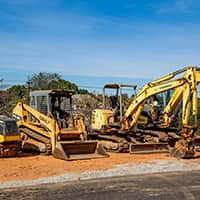The History of Heavy Construction Equipment
Written by Staff Writer

Heavy equipment includes a variety of specialized vehicles designed to tackle different aspects of heavy construction, particularly earthwork and material handling. Excavation tasks often involve machines like backhoes, excavators and drag line excavators, which are built for digging and removing large quantities of soil or debris. Graders and bulldozers are essential for leveling and preparing surfaces, while wheel tractor scrapers combine cutting, loading and hauling functions for moving earth.
Many other pieces of equipment are also involved in other construction tasks, including loaders, trenches, dump trucks, tower cranes, forklifts and pavers. And the designs of all of these machines have evolved over centuries to meet the growing demands of construction and infrastructure projects.
Early Innovations: The Roman Legacy
The origins of heavy equipment can be traced back to ancient Rome, where ingenious engineers developed early versions of tools that revolutionized construction. One of their key innovations was the crane, powered by either human or animal labor. This versatile device became a cornerstone of construction and remained in use well into the Middle Ages and its descendants are still in use today.
The Late 1800s: Machines for Farming and Industry
In the United States, the Second Industrial Revolution marked a period of transformation driven by urbanization and westward expansion. Farmers and entrepreneurs sought ways to increase efficiency, leading to groundbreaking inventions in machinery.
One of the most notable inventions of this time period is the combine harvester. Developed by Hiram Moore in 1836, the combine harvester significantly increased the productivity and efficiency of farming. The harvester was later improved upon by Benjamin Leroy Holt, who developed the caterpillar track and applied it to the harvester in order to move effectively and operate in areas in which wheeled machines would get stuck.
Other notable inventions of the 1800s include the steam engine tractor and, later, the gas-powered tractor, both credited to Daniel Best. John Froelich took innovation further in 1892 by adding forward and reverse gears to the gasoline-powered tractor. These early machines set the stage for the development of today's heavy construction equipment.
1900-20: Transition to Construction Machinery
As the 20th century dawned, agricultural machines began evolving into tools for construction. Galion Iron Works, established in 1907, became a prominent manufacturer of equipment like steamrollers, motor graders and hydraulic cranes, paving the way for modern construction technology.
1920-30: The Birth of the Bulldozer
The 1920s saw the invention of the bulldozer, an adaptable machine originally known as the "bull grader." Farmers favored these machines for their ability to clear tree stumps and level rough terrain, aided by caterpillar tracks for traction. By the 1930s, the term "bulldozer" had become widely adopted, cementing its place in construction history.
1930-50: The Struggles of the Depression and War
The Great Depression brought challenging times to the construction industry. With limited resources, companies struggled to innovate and often had to liquidate assets to survive. These hardships extended into World War II, further slowing advances in heavy machinery. But despite the economic strain, remarkable projects like the Golden Gate Bridge were completed during this era, showcasing resilience and ingenuity.
1950-60: Suburban Growth and Highway Expansion
The post-war Baby Boom spurred a migration of families from cities to suburban areas, creating a surge in construction demand. The Federal-Aid Highway Act of 1956, along with the Interstate Highway System's development, significantly increased the need for heavy equipment. This period marked a revival for the construction industry, with machinery playing a critical role in shaping the American landscape.
1960-70: Embracing Hydraulic Technology
The Interstate Highway System's construction spanned 35 years, transforming the nation's infrastructure. During this time, operators discovered the superior efficiency of hydraulic equipment compared to traditional cable-operated machinery. As demand for large-scale projects like surface mining grew, construction equipment became increasingly massive and robust.
1970-80: Safety and Energy Challenges
The complexity of construction machinery in the 1970s led manufacturers to prioritize operator safety features. The 1973 oil embargo revitalized the American coal industry, driving demand for compact wheel loaders and mining equipment. This era highlighted the need for safer and more efficient machines in an evolving industrial landscape.
1980-90: Industry Decline
Following the completion of the Interstate Highway System, the heavy equipment industry entered a downturn. Among the four major American manufacturers of construction equipment, Caterpillar emerged as the sole survivor, navigating the recession that reshaped the industry's competitive landscape.
1990-2000: Environmental Regulations and Innovation
The 1990s marked a turning point as environmental laws began to influence heavy equipment manufacturing. In 1996, the first diesel engine emissions regulations were introduced, prompting manufacturers to prioritize fuel efficiency in their designs.
2000-10: Regulatory Evolution and Market Adaptation
Two significant sets of U.S. Environmental Protection Agency (EPA) regulations transformed the industry. Operating costs for heavy equipment rose, prompting construction companies to favor renting machinery over purchasing it. Durability became a critical factor, as companies sought cost-effective solutions to meet stricter environmental standards.
2010-Present: The Age of Innovation
The construction machinery industry has entered a period of rapid growth in recent years. The U.S. Bureau of Labor Statistics (BLS) predicts a 10% increase in equipment operator employment through 2024. Advances in technology have led to the development of autonomous machines, enhanced customer-focused solutions and innovations aimed at extending machinery lifespans and maximizing uptime.
